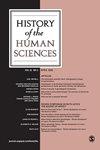Reanimating experimental psychology: Media archaeology, Hugo Münsterberg, and the ‘Testing the Mind’ film series
IF 0.5
2区 历史学
Q2 HISTORY & PHILOSOPHY OF SCIENCE
引用次数: 0
Abstract
For historians of psychology, Hugo Münsterberg is best remembered as William James’ successor as director of the Harvard Psychological Laboratory and a pioneer of applied psychology. By contrast, for film and media studies scholars, Münsterberg is recognized less for his contributions to experimental psychology than for those to film theory, a field in which his penultimate book, The Photoplay: A Psychological Study (1916), is frequently claimed as an inaugural text. However, lost in the blind spots of both disciplinary perspectives has been a thorough examination of Münsterberg's collaboration with Paramount Pictures, translating psychological tests into experimental short films. Despite reaching millions of moviegoers in 1916, Münsterberg’s ‘Testing the Mind’ series has received little attention from historians of science and early cinema alike. One reason for this neglect is that, to date, not a single extant copy of a ‘Testing the Mind’ release has been located. This article is about the author's efforts, in collaboration with students, to reanimate these lost psychological tests for the screen through meticulous historical reconstruction based on the original scripts, journalistic accounts, and correspondence between Münsterberg and Paramount. This reconstructive process, I show, yields new insights into the relationship between psychology and early cinema and an opportunity for reflection on this promising new space for research at the intersection of media archaeology, the history of psychology, and experimental history of science. Film URL: https://archive.org/details/munsterberg_paramount.pictographs重振实验心理学:媒体考古学、雨果-明斯特伯格和 "测试心灵 "系列电影
对于心理学历史学家来说,雨果-明斯特伯格是作为威廉-詹姆斯的继任者、哈佛心理实验室主任和应用心理学的先驱而为人们所熟知的。相比之下,对于电影和媒体研究学者来说,明斯特伯格被认可的原因与其说是他对实验心理学的贡献,不如说是他对电影理论的贡献:在这一领域,他的倒数第二部著作《影戏:心理学研究》(1916 年)经常被称为开山之作。然而,在这两种学科视角的盲点下,对明斯特伯格与派拉蒙电影公司合作,将心理测试转化为实验短片的深入研究却被忽略了。尽管明斯特伯格的 "心灵测试 "系列电影在 1916 年就吸引了数百万电影观众,但却很少受到科学史学者和早期电影学者的关注。造成这种忽视的原因之一是,迄今为止,还没有找到一部现存的 "心灵测试 "版本。本文讲述了作者与学生合作,根据原始剧本、新闻报道以及明斯特伯格与派拉蒙之间的通信,通过细致的历史重建,努力将这些失传的心理测试重新搬上银幕。我将展示这一重建过程,它将为心理学与早期电影之间的关系提供新的见解,并为反思媒体考古学、心理学史和科学实验史交汇处的这一充满希望的新研究领域提供机会。影片网址:https://archive.org/details/munsterberg_paramount.pictographs
本文章由计算机程序翻译,如有差异,请以英文原文为准。
求助全文
约1分钟内获得全文
求助全文
来源期刊

History of the Human Sciences
综合性期刊-科学史与科学哲学
CiteScore
1.60
自引率
11.10%
发文量
31
审稿时长
>12 weeks
期刊介绍:
History of the Human Sciences aims to expand our understanding of the human world through a broad interdisciplinary approach. The journal will bring you critical articles from sociology, psychology, anthropology and politics, and link their interests with those of philosophy, literary criticism, art history, linguistics, psychoanalysis, aesthetics and law.
 求助内容:
求助内容: 应助结果提醒方式:
应助结果提醒方式:


